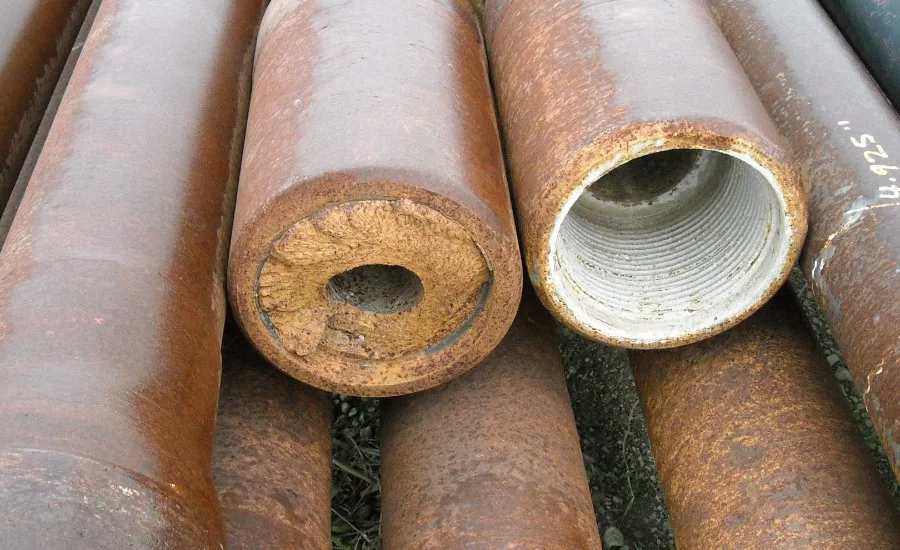Metal Fatigue: The Silent Killer for Drill Pipe
What is Metal Fatigue, and How can Drillers Minimize it?

Connections can be a major stress point in drill pipe. Drill pipe design at manufacturing and drill string design in the field can both alleviate unnecessary stress on working pipe.
Source: David King photo
Metal fatigue is the process by which a material is slowly and progressively damaged by stresses and strains not strong enough to cause immediate breakage.
In HDD drilling where the drill pipe rotates during drilling, this rotation continues through the bend as it passes through the curved part of the drill path. Pipe “in the bend” compresses on the inside of the curve and stretches on the outside. During each rotation, the pipe compresses and stretches. This stresses the metal and leads to fatigue.
In the late ’90s when HDD for utilities took off, many drill rig buyers were caught off guard when their drill pipe broke sooner than they thought it should, even though it had little wear. HDD drilling contractors learned to just replace their drill pipe after so many drilling hours, maybe 1,600 or so, determined by their experience. Even so, you could be on a difficult job and have your drill pipe survive only to see it fail a few weeks later on an easy job. This was later avoided in some applications by using mud motors and sliding the drill pipe instead of rotating it, depending on drill pipe rotation.
But water wells and blastholes are supposed to be straight vertical holes. You would think this avoids the “rotating through the bend” issue. But too much down pressure can bow out drill pipe, creating rotation during the bend. This can create stress on the drill pipe body, but especially the connections causing pin breaks.
The act of drilling causes stresses. Drilling vibrations and DTH hammer percussions travel up the drill string. We can see and hear it when we drill. Drill pipe designers and drill rig designers are very aware of stresses. They look at areas that might collect stress and, through the geometry of the item, try to distribute that stress over a wider area. This redistribution employs radii and designs that move stress-gathering areas away from sensitive areas.
Oil and gas drill pipe often uses stress-relieving grooves on pin connections and “bore back” boxes. It seems counter-intuitive to machine away metal to make an area stronger, but a stress-relieving groove does just that. Instead of following the taper of the male connection, a large radius is machined. This increases the surface space over which the stress applies. Sometimes hammer bits employ this technique at the base of the shank.
If you were to cross-section the weld area of a drill pipe, you would see how the internal tail design helps with stress distribution. Manufacturers take care so as not to make the weld zone also a stress point. Hopefully, you do not get the opportunity to see because of a broken drill pipe.
I recently had a discussion with a drilling contractor who had two failed drill rods within a couple of days. They were 4½-inch drill rods worn to 4⅜-inches in diameter. That would leave about a .275-inch wall. Not break-worthy, but perhaps a concern. When I asked when they purchased the rods, they said it would have been at least eight years ago. Perhaps fatigue was a factor.
Shock absorbers can help reduce the vibrations of the bit and/or DTH hammer action from traveling through drill pipe to the drill head. Some shock absorbers are attached to the head of the rig. A floating spindle sub reduces some, but actual shock absorbers do better. Some operators swear by these devices to prevent damage to the drill head, and some that say they can cause more problems than they solve. There are also shock absorbers that run above the DTH hammer. It seems to make sense to reduce the vibrations here, but you also subject a relatively expensive item to downhole wear. Several companies offer these and your regular DTH hammer sources can likely help.
If you think it was fatigue, note the diameter. If you notice that failures start at a known diameter, you can weed out your drill pipe before it fails.
Drill string design can also help. Use a stabilizer, drill collar and/or a heavy wall starter rod to help absorb some of the vibrations. Keep in mind that difficult drilling conditions can increase the vibrations and stresses. This could be a concern for some contractors and not so much so others.
Drilling produces vibrations and shock waves that can travel through our drill strings. This can create fatigue. You cannot measure fatigue or see it without metallurgical analysis. We can make sure we follow good drilling practices to avoid adding stress to our tooling. When we have a drill pipe failure, what caused it? If you think it was fatigue, note the diameter. If you notice that failures start at a known diameter, you can weed out your drill pipe before it fails as the HDD operators did. If you think fatigue is a real problem, try a shock absorber.
When we get fatigued, rest helps. When drill pipe gets fatigued, the damage is permanent. If you think it is a problem, do what you can to reduce the stress and use history as a guide to help you take a drill pipe out of service before trouble strikes.
Looking for a reprint of this article?
From high-res PDFs to custom plaques, order your copy today!




